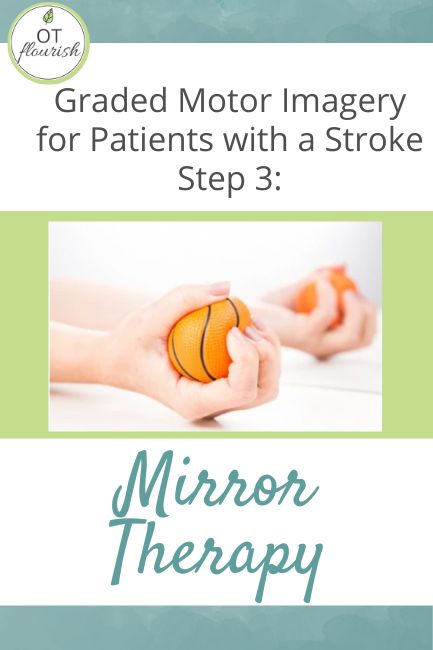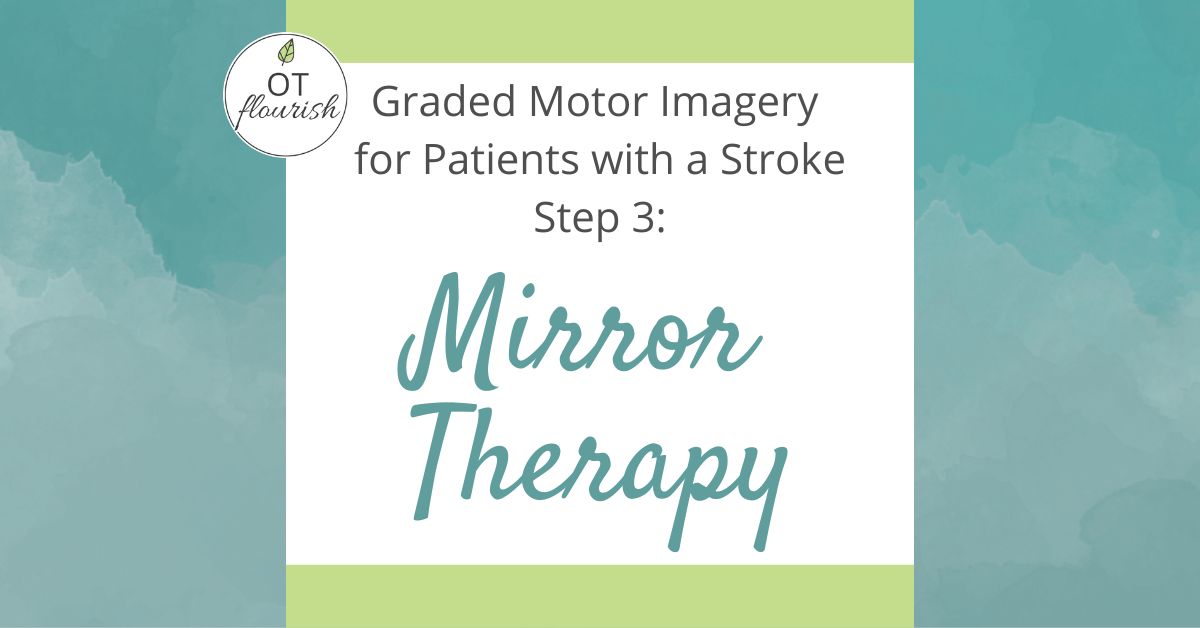Ever have a patient with a stroke and wonder if mirror therapy intervention would work? I remember as a new occupational therapy grad watching other OTs using a mirror in treatment, wondering what the purpose was and if it truly helped our patients make progress.
I made it a mission to find out:
📌 what it is
📌 the benefits
📌 what do OT practitioners need to do in order to utilize this with their patients
📌 how to have patients do this as a home exercise program
Let me share what I found:
In my experience, many OTPs, and that included me until I knew better 😬, jump straight to mirror therapy (step 3 in the Graded Motor Imagery continuum) with the patient before they were able to achieve the first two steps:
Step 1: Left-Right Discrimination
Step 2: Explicit Motor Imagery

What is Graded Motor Imagery?
Graded Motor Imagery a set of 3 different, sequential (but flexible) treatment techniques using “top down” cortical central processing to improve movement difficulties or complex pain.
What’s the Best Way to Use Mirror Therapy? On the Graded Motor Imagery Continuum!
Remember we talked about the 3 steps of graded motor imagery and that it must be done in order to achieve optimal results?
Here are the steps:
- Laterality Training (aka Left-Right Discrimination)
- Explicit Motor Imagery Exercises
- Mirror Therapy
What is Mirror Therapy Good For?
Mirror therapy is a therapeutic technique that involves the use of a mirror to create a visual illusion of a functional limb or body part where there may be a perceived loss of function.
The affected limb is moving as the person is looking at the unaffected extremity in the mirror, which helps create new neural connections for motor system recovery. It is commonly used in the rehabilitation of individuals with various neurological and musculoskeletal conditions such as phantom limb pain, stroke rehabilitation, complex regional pain syndrome (CRPS), there is some evidence it can be used for orthopedic injuries and rehabilitation after surgery, as well as cerebral palsy.
Ever heard the saying, “seeing is believing?” 😮
Check out the OT Accelerator for step-by-step instructions and research on how to exactly use both Laterality Training and Imagery Training in your OT practice.
What Does Mirror Therapy Do To The Brain?
The benefits of mirror therapy works by leveraging the brain’s remarkable ability to reorganize itself, a phenomenon known as neuroplasticity. Imagine you have a limb that’s not functioning properly due to injury, stroke, or other conditions. The brain, responsible for controlling movements, might still send signals trying to move the impaired limb. However, if the actual movement is limited or absent, the brain might struggle to recognize the intended actions. It helps bridge this gap by providing visual feedback to the brain.
How Mirror Therapy Works and What Patients are Appropriate To Use This Intervention?
It is typically used with patients who present with motor function deficits with loss of function of a body part and usually left-right discrimination difficulties are noted. Research supports the effectiveness of mirror therapy with use for patients with stroke, chronic pain and/or impaired sensation.
Mirror therapy for stroke rehabilitation is based on visual stimulation. A mirror is placed in the patient’s midsagittal plane with the purpose of reflecting the movement of the mobile side as if it were the affected side. It is meant to give the illusion of “normal” movement on the affected side in order to stimulate adequate brain regions for movement.
How Do I Use It With My Patients?
1️⃣ Make sure your patient is in a supported position so they can focus on the task at hand.
2️⃣ Use a mirror box or mirror facing the unaffected extremity with the affected extremity hidden behind the mirror.
3️⃣ Have your patient observe the unaffected extremity in the mirror without moving and imagining it is the affected extremity. Start with little to no movement.
4️⃣ Have your patient slowly begin to move the unaffected extremity while watching the reflection and relaxing the affected extremity.
5️⃣ Then have your patient move both the unaffected and affected extremity simultaneously while focusing on the reflection.
6️⃣ Gradually increase the difficulty of the exercises.
How Often Should You Do Mirror Therapy?
This treatment method is beneficial three to five times per day.
How Long Does it Take for Mirror Therapy to Work?
The time it takes for mirror therapy to show significant results can vary widely depending on several factors, including the individual’s specific condition, the severity of the issue being addressed, and the consistency of the therapy. Some individuals may start experiencing improvements in a relatively short period, while others may require a more extended timeframe.
For certain acute conditions, individuals might notice positive changes within a few weeks of consistent mirror therapy. However, for chronic or more complex issues, it may take several weeks to months of regular practice to see substantial benefits.
It’s important to approach it as a complementary intervention within a comprehensive treatment plan and best results occur within the graded motor imagery continuum. Additionally, individual responses to therapy can differ, so patience and ongoing communication with healthcare professionals or therapists are crucial. Regular assessments and adjustments to the therapy plan may be necessary to optimize its effectiveness for each person’s unique circumstances.
How Do I Make One For My Patient?
At its most basic form, it is just a box with a mirror on the side. It has a space for each extremity on either side. The affected side will be covered and the unaffected extremity will be reflected in the mirror.
Try making a mirror box with your patients and sending it home!
I also ❤️ that mirror visual feedback therapy can easily be generalized to home use, is a great home exercise program and will increase benefits and potential outcomes.
A mirror therapy app to consider is Digital Mirror Therapy™ (DigitalMT). It is an augmented reality app which allows the patient to move their body freely, letting them work on more than one body part at a time or a “curtain” function, which allows them to focus on an individual limb.
Review of the Benefits
Mirror therapy is an easy and low cost intervention technique that can be used for stroke patient with left-right discrimination or loss of limb function (either total or partial). It technically “tricks” the mind into thinking that the affected extremity is moving. It stimulates the brain neurons and can jump start your motor system recovery!
It is step 3 in the graded motor imagery continuum and don’t for-go the first two steps or you’ll miss out on the incredible results it can provide when done correctly.
Another great thing about this technique is that it’s an intervention that can easily be generalized to home use. Patients can easily incorporate this intervention into home life to increase benefits and potential outcomes.







